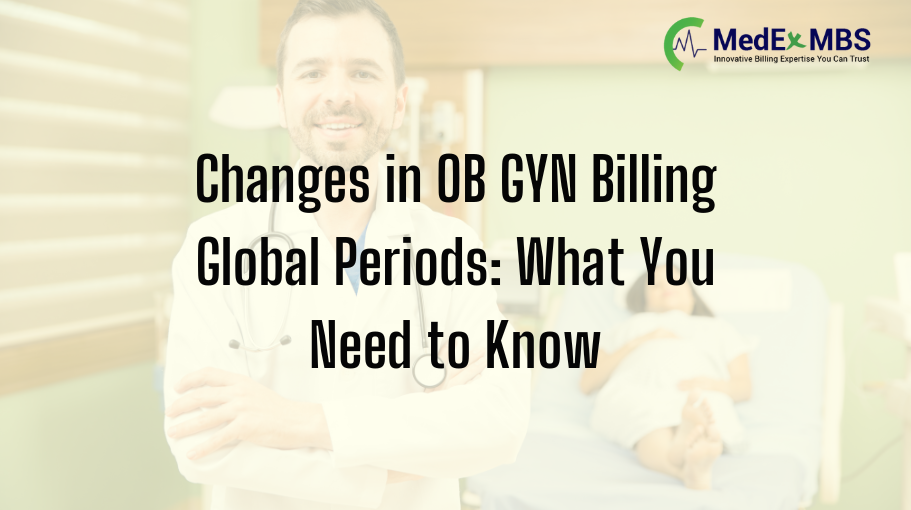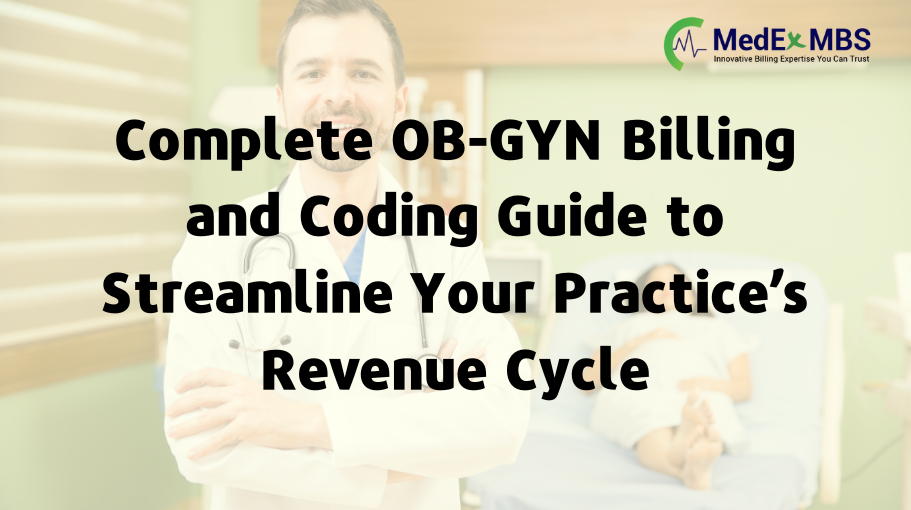Changes in OB GYN Billing Global Periods: What You Need to Know

Only one specific area has been modified. In 2025, new telehealth CPT codes were introduced; however, the adoption by Medicare remains limited. Being aware of these updates safeguards your revenue and ensures compliance, as improper obstetric global billing consistently ranks among the leading causes of claim denials. What is a Global Period in OB GYN? Global-period billing includes prenatal, delivery, and postpartum services consolidated into a single bundled reimbursement for obstetrical care. Instead of billing individually for each prenatal appointment, delivery, and postpartum care, you submit one all-encompassing code that addresses the complete pregnancy experience from the initial prenatal visit to the concluding postpartum examination. The global package typically includes postpartum care for six weeks following delivery, after which additional visits necessitate separate billing. This is distinct from surgical global periods that utilize specific day counts, such as 10-day or 90-day periods. OB-GYN global billing encompasses the entire range of routine pregnancy care, irrespective of duration. Core Codes You Need to Know Global Package Codes Utilize when your practice provides comprehensive pregnancy care: 59510: Cesarean delivery with complete care. 59610: Vaginal birth after previous cesarean with complete care. 59618: Cesarean after attempted VBAC with complete care. Component Codes Utilize when you only manage part of the pregnancy care: 59409/59514: Delivery only (vaginal/cesarean). 59425: Antepartum care, 4-6 visits. 59426: Antepartum care, 7+ visits. 59430: Postpartum care only. Decision Rule: Did you only manage certain aspects while other providers took care of different parts? Utilize component codes. New Telehealth CPT Codes with Limited Medicare Recognition New CPT codes have been introduced for the year 2025, which include 98000-98007 (audio-video), 98008-98015 (audio-only), and 98016 (brief communication). These codes inherently represent telehealth services and do not necessitate modifier 95. However, Medicare currently acknowledges only 98016; 98000-98015 are not reimbursable by Medicare (although some commercial plans may cover them). Virtual consultations that are included in standard prenatal or postpartum care continue to be part of the global package. They cannot be billed separately merely because they are performed through telehealth. However, telehealth consultations for complications or issues that fall outside the standard global package may be billed separately using the relevant evaluation and management codes or code 98016 when applicable. What Did NOT Change? CPT codes remain unchanged from 2024. Global package regulations have not altered. Bundling principles remain consistent. The regulations regarding split and shared visits will persist from 2024, upholding the same substantive portion requirements and the use of modifier FS (applicable only to facility settings). Services that were eligible for separate billing in 2024 will remain eligible for separate billing in 2025. Telehealth Rules for 2025 Bundled services will remain bundled irrespective of the delivery method. Routine prenatal telehealth appointments, virtual postpartum check-ups, and standard pregnancy education sessions held online are encompassed within your global package payment. What Can You Bill Separately? Telehealth visits addressing complications. Virtual care for unrelated medical issues. Coding Requirements Utilize service code 02 for alternative telehealth locations or 10 for a patient’s residence. For traditional E/M codes, most commercial insurers require modifier 95, although Medicare requirements differ by MAC. The recently introduced telehealth CPT codes (98000-98015) do not necessitate the use of modifier 95, as telehealth is inherently encompassed within the code description; nevertheless, it is crucial to highlight that Medicare does not recognize these codes. Important Note Medicare’s expanded telehealth flexibilities (including home as the originating site) are effective until September 30, 2025. Code 98016 supersedes HCPCS G2012 for brief communications. Making the Right Choice: Global vs Component Codes Use Global Codes When Your practice manages the entire pregnancy. Use Component Codes When The patient transitions between practices. You only perform delivery without providing prenatal care. Another practice manages postpartum care. Real Examples A patient moves to a different location during pregnancy: The initial practice charges for the antepartum code, whereas the new practice charges for the global code. Hospital delivery involving a different obstetric group: The prenatal practice charges for the antepartum code, while the hospital group charges for the delivery-only code. You handle the call and provide an unknown patient: Charge the delivery-only code. Essential Modifiers for 2025 Essential Modifiers You Should Use Modifier 25: Significant, separately identifiable E/M service on the same day as another procedure (note that this modifier is often misapplied in OB claims, so ensure proper documentation). Modifier 95: Telehealth services when utilizing traditional E/M codes (not required for new telehealth-specific CPT codes). Modifiers That Don’t Belong on OB Claims Modifier 90: Laboratory services for reference (not applicable during global periods). Modifier 91: Laboratory tests repeated (not applicable during global periods). These laboratory modifiers are irrelevant to obstetric global billing and can cause confusion in claims. Understanding Various Payer Requirements Medicare’s Strategy for OB Global Billing Medicare employs the “MMM” indicator for obstetric global packages, setting them apart from surgical global periods. Telehealth coverage remains available until September 30, 2025, allowing patients to access services from home without geographic limitations. Commercial Insurance Differences Many insurers align with Medicare’s guidelines but may exhibit particular variations: The precise number of postpartum visits included. Distinct telehealth stipulations. State-specific regulations (such as North Carolina’s new F-codes effective after July 1, 2025). It is essential to confirm the policies of individual payers instead of presuming consistent coverage. How to Accurately Bill for OB/GYN in 2025? Standard Pregnancy Care The patient receives comprehensive prenatal care, undergoes delivery, and completes postpartum care within your practice. Code: Employ the correct global code (59400, 59510, etc.) Mid-Pregnancy Transfer If a patient transfers to your practice at 28 weeks, you will provide continuous care and delivery. Code: Apply the global code as you have delivered significant antepartum care along with the delivery. Telehealth for Postpartum Complications Should a patient experience postpartum depression necessitating a virtual consultation beyond standard care? Code: Utilize the appropriate E/M code
Complete OB-GYN Billing and Coding Guide to Streamline Your Practice’s Revenue Cycle

Best Practices in Gynecology Coding In the realm of gynecology coding, it is imperative to uphold high standards to ensure accurate billing and comprehensive patient care. By diligently documenting procedures and selecting the correct CPT codes according to the surgical approach and complexity, practices can guarantee an accurate representation of the services provided. This methodology not only facilitates efficient reimbursement processes but also maintains compliance with regulatory standards, ultimately improving the overall operational effectiveness of the gynecological practice. Procedure Type CPT Code Range Abdominal hysterectomy 58150-58210 Vaginal hysterectomy 58260-58291 Laparoscopic hysterectomy 58541-58573 By implementing these stringent standards, gynecologists can accurately capture the intricacies of each procedure, which contributes to enhanced financial health and patient outcomes within their practice. What Are CPT Codes and How They Relate to Gynecology? CPT (Current Procedural Terminology) codes are standardized codes utilized to denote medical, surgical, and diagnostic services. Created by the American Medical Association (AMA), these codes promote uniformity and precision in documenting and billing healthcare services across diverse medical practices. Role of CPT Codes in Gynecology In gynecology, CPT codes offer precise documentation for a wide range of procedures and services. Codes ranging from 56405 to 58999 encompass everything from minor diagnostic tests to significant surgical operations. These codes ensure that providers receive suitable reimbursement and maintain precise patient records. The proper application of gynecology CPT codes bolsters the financial stability of medical practices. This, in turn, improves the quality of care by guaranteeing that all services are documented and billed accurately. Understanding and utilizing these codes is crucial for effective healthcare delivery. How do CPT Codes Classify Gynecology into Specific Categories? Gynecology CPT codes classify the specialty into specific categories for billing and documentation purposes. These codes organize various medical services associated with women’s reproductive health, ensuring accurate reimbursement and proper record-keeping. Evaluation and Management (E/M) Codes Imaging / Radiology Codes Surgical Procedure Codes Laboratory and Pathology Codes Pharmaceutical Codes The precise application of these categories in gynecology CPT codes guarantees thorough documentation, accurate billing, and effective management of a wide range of healthcare services pertaining to women’s reproductive health. 1. Evaluation and Management (E/M) Codes E/M codes classify office visits and wellness evaluations in gynecology. These codes ensure that healthcare providers bill appropriately for the level of service rendered, considering the complexity of patient history, medical decision-making, and preventive counseling. Accurate documentation is crucial to support the correct application of E/M codes and ensure adherence to billing regulations, thus facilitating comprehensive healthcare management for women’s reproductive health. 99202-99215 Office visits range from problem-focused to comprehensive evaluations. 99384-99387 Annual wellness visits for new patients aimed at preventive management. 99394-99397 Annual wellness visits for established patients focused on preventive management. 99401-99404 Counseling codes for preventive services such as contraceptive counseling. 81025 Detects human chorionic gonadotropin (hCG) in urine to confirm early pregnancy status. 88164-88167 Codes for cervical cancer screening procedures like Pap smears. Evaluation and Management (E/M) codes are essential for billing gynecological services, which include everything from routine office visits to extensive preventive care. Healthcare providers employ these codes to accurately bill and document the level of service rendered, ensuring adherence to healthcare billing regulations and promoting optimal patient care in women’s reproductive health. 2. Imaging / Radiology Codes Radiology codes related to gynecology cover a range of imaging studies designed for specific conditions and anatomical areas. These codes are vital for diagnosing and managing various gynecological issues, ensuring accurate treatment planning and patient care. CPT Code Description 72193 Computed Tomography (CT) Pelvis: This code provides detailed scans of the pelvic area, which are crucial for diagnosing conditions such as uterine fibroids. 72195 Magnetic Resonance Imaging (MRI) Pelvis: This imaging technique uses magnetic fields to examine pelvic organs, assisting in the identification of conditions like ovarian cancer. 76830 Transvaginal Ultrasound: This procedure delivers detailed images of the uterus, cervix, and ovaries, which are essential for diagnosing issues such as endometrial abnormalities. 74740 Hysterosalpingography: This involves X-rays with contrast dye to evaluate the uterine cavity and fallopian tubes, which is beneficial in infertility assessments. 4. Laboratory and Pathology Codes Laboratory and pathology codes in gynecology encompass a variety of tests and procedures that are essential for diagnosing and monitoring women’s health conditions. These codes guarantee accurate reporting and billing for numerous diagnostic tests and pathology studies specifically designed for gynecological care. Diagnostic Tests CPT Code Description 76856 Pelvic ultrasound: This test employs sound waves to examine the pelvic region, including the uterus and ovaries, to detect any abnormalities. 58555 / 58558 Hysteroscopy: This procedure uses a slender, illuminated tube to inspect the uterus for issues such as fibroids or polyps. STI Testing Testing for Chlamydia and Gonorrhea (87491, 87591, 87850, and 87800): These examinations are conducted to identify sexually transmitted infections, which are crucial for prompt detection and treatment. Screening Procedures CPT Code Description 88141 / 88142 / 88143 Pap smear: This test analyzes cervical or vaginal smears to identify abnormal cells, aiding in the early detection of cervical cancer. 87624 / 87625 HPV testing: This test detects human papillomavirus infections, which are important for assessing the risk of cervical cancer and guiding treatment decisions. Biopsy Procedures Endometrial biopsy (58100, 58110, and 58120): This procedure involves the collection of tissue samples from the uterine lining to diagnose various conditions, including abnormal bleeding and endometrial cancer. These codes are essential in healthcare management as they enable precise diagnosis, treatment planning, and the development of disease prevention strategies that are specific to women’s reproductive health. 5. Pharmaceutical Codes Pharmaceutical codes related to gynecology include medications and treatments that are vital for managing health conditions affecting women. These codes guarantee accurate billing and documentation for a range of pharmaceutical interventions designed to meet the needs of gynecological care. Procedures and Interventions CPT Code Description 58555 Hysteroscopy,
